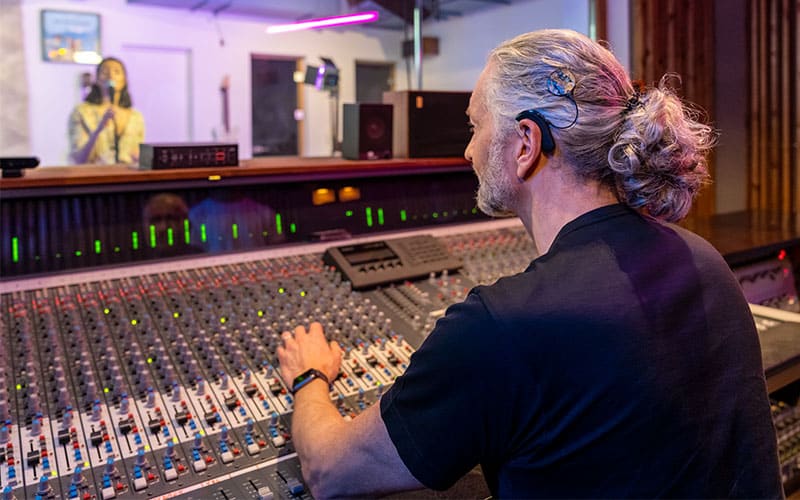
MED-EL
Published Nov 07, 2023
Music & Sound Quality With MED-EL Cochlear Implants, Part 1
In the quest to understand the profound appeal of music and its capacity to evoke deep emotions, researchers faced a complex challenge: translating music into electrical signals for cochlear implant recipients. While these devices excelled at speech comprehension, the enjoyment of music remained elusive, until MED-EL's pioneering approach introduced the Fine Structure Processing (FSP) coding strategy in 2008, revolutionizing music perception and sound quality for implant users.

Music produces a kind of pleasure which human nature cannot do without.
Confucius
Prior to 2008, music perception studies revealed that while recipients did listen to music through their cochlear implants and there were (and still are) individual differences in music preference, poor music listening experiences were a widespread problem.Pijl S. (1997). Labeling of musical interval size by cochlear implant patients and normally hearing subjects. Ear Hear, 18(5), 364-372. doi:10.1097/00003446-199710000-00002[1]
In general, people reported enjoying music less after implantation than prior to their hearing loss.Gfeller, K., Christ, A., Knutson, J.F., Witt, S., Murray, K.T., & Tyler, R.S. (2000). Musical backgrounds, listening habits, and aesthetic enjoyment of adult cochlear implant recipients. Journal of the American Academy of Audiology, 11(7), 390-406.[2]
| Cochlear Implant Recipient DescriptionsGfeller, K., Witt, S., Woodworth, G., Mehr, M.A., & Knutson, J. (2002). Effects of frequency, instrumental family, and cochlear implant type on timbre recognition and appraisal. The Annals of otology, rhinology, and laryngology, 11(4), 349-356. doi:10.1177/000348940211100412[3] | Natural Hearing Listeners Descriptions |
| Unpleasant, something to avoid | Rich |
| Difficult to follow | Resonant |
| Scattered | Emotional |
| Noisy | Delightful |
| Dull | Stirring |
| Distorted | Soothing |
| Harsh | Memorable |
| Shrill | Pleasant as a background |
| All the instruments and lyrics blurred together | Desire or excitement to hear a favorite song |
MED-EL’s founders initially developed the cochlear implant to improve communication ability, but as they met that goal, they quickly realized good speech understanding was only part of the picture.Hochmair-Desoyer, I.J., Hochmair, E.S., Fischer, R.E., & Burian K. (1980). Cochlear prostheses in use: recent speech comprehension results. Archives of oto-rhino-laryngology, 229(2), 81-98. doi:10.1007/BF00454232[4] That’s why they turned their attention to restoring music enjoyment to people with hearing loss.
MED-EL’s Keys to Success
MED-EL’s signal processing researchers wanted to develop a sound coding strategy that could encompass both the envelope and the fine structure.
- Early Research
Early work on stimulating the cochlea’s different areas showed that low pitches were represented in the cochlea’s deepest part, known as the apex, and that fine structure cues are related to pulse timing, which are only recognized by that same apical low frequency region.Hartmann, R., & Klinke, R. (1995). Spatial and temporal resolution in multichannel cochlear implants. The Annals of Otology, Rhinology & Laryngology Supplement, 166, 113-115.[5]Wilson, B.S., Schatzer, R., Lopez-Poveda, E.A., Sun, X., Lawson, D.T., & Wolford, R.D. (2005). Two new directions in speech processor design for cochlear implants, Ear Hear, 26(4 Suppl), 73S-81S. doi:10.1097/00003446-200508001-00009[6] - Long Electrode Arrays
MED-EL’s researchers knew they had an advantage. The MED-EL electrode array was the only electrode long enough to potentially reach deep enough into the cochlea and target this low frequency region of the apex.Gstoettner, W., Baumgartner, W.D., Hamzavi, J., & Franz, P. (1997). Surgical experience with the Combi 40 cochlear implant. Advances in Oto-Rhino-Laryngology, 52, 143-146. doi:10.1159/000058975[7]Gstoettner, W., Franz, P., Hamzavi, J., Plenk, H. Jr., Baumgartner, W., & Czerny, C. (1999). Intracochlear position of cochlear implant electrodes. Acta Oto-Laryngologica, 119(2), 229-233. doi:10.1080/00016489950181729[8]Dorman, M.F., Loizou, P.C., & Rainey, D. (1997). Simulating the effect of cochlear-implant electrode insertion depth on speech understanding. The Journal of Acoustical Society of America, 102(5 Pt 1), 2993-2996. doi:10.1121/1.420354[9]Hochmair, I., Arnold, W., Nopp, P., Jolly, C., Müller, J., & Roland, P. (2003). Deep electrode insertion in cochlear implants: apical morphology, electrodes and speech perception results. Acta Oto-Laryngologica, 123(5), 612-617.[10] - Free-Fitting Electrode Arrays
Furthermore, MED-EL could accomplish this deep insertion using MED-EL’s flexible free-fitting electrode arrays and without causing additional trauma to the cochlea’s delicate tissues.Gstoettner, W., Plenk, H. Jr., Franz, P., et al. (1997). Cochlear implant deep electrode insertion: extent of insertional trauma. Acta Oto-Laryngologica, 117(2), 274-277. doi:10.3109/00016489709117786[11]Gstoettner, W.K., Baumgartner, W.D., Franz, P., & Hamzavi, J. (1997). Cochlear implant deep-insertion surgery. Laryngoscope, 107(4), 544-546. doi:10.1097/00005537-199704000-00022[12]Carlson, M.L., Driscoll, C.L., Gifford, R.H., et al. (2011). Implications of minimizing trauma during conventional cochlear implantation. Otology & Neurology, 32(6), 962-968. doi:10.1097/MAO.0b013e3182204526[13]Helbig, S., Baumann, U., Hey, C., & Helbig, M. (2011). Hearing preservation after complete cochlear coverage in cochlear implantation with the free-fitting FLEXSOFT electrode carrier. Otology & Neurotology, 32(6), 973-979. doi:10.1097/MAO.0b013e31822558c4[14]Pillsbury, H.C. 3rd, Dillon, M.T., Buchman, C.A, et al. (2018). Multicenter US Clinical Trial with an Electric-Acoustic Stimulation (EAS) System in Adults: Final Outcomes. Otology & Neurotology, 39(3), 299-305. doi:10.1097/MAO.0000000000001691[15]Skarzynski, H., Lorens, A., Zgoda, M., Piotrowska, A., Skarzynski, P.H., & Szkielkowska, A. (2011). Atraumatic round window deep insertion of cochlear electrodes. Acta Oto-Laryngologica, 131(7), 740-749. doi:10.3109/00016489.2011.557780[16]O'Connell, B.P., Hunter, J.B., & Wanna, G.B. (2016). The importance of electrode location in cochlear implantation. Laryngoscope Investigative Otolaryngology, 1(6):169-174. doi:10.1002/lio2.42[17]
MED-EL’s developers had the necessary ingredients, all they needed was the algorithm to make the ingredients work better together, and so they accepted the challenge to bring back music enjoyment to people who listen with cochlear implants.
A Solution to the Music Coding Problem
A significant problem in cochlear implant development existed: cochlear implant recipients were able to score very well on speech understanding tests, in both quiet and noise, even though the sound quality they experienced through their implant was poor, robotic, or cartoon-character-like, and they struggled to enjoy listening to music.
MED-EL is the only cochlear implant manufacturer that has released a new coding strategy since 2008. A coding strategy tells the implant’s audio processor how to analyze the sound coming into the microphone and how to stimulate the implanted electrodes based on that sound. MED-EL introduced the Fine Structure Processing (FSP) coding strategy* in 2008, and further refined the coding strategies (FS4 and FS4-P) introduced in 2014.
Fine structure coding improved speech understanding in both quiet and noise,Arnoldner, C., Riss, D., Brunner, M., Durisin, M., Baumgartner, W.D., & Hamzavi, J.S. (2007). Speech and music perception with the new fine structure speech coding strategy: preliminary results. Acta Oto-Laryngologica, 127(12), 1298-1303. doi:10.1080/00016480701275261[18]Riss, D., Arnoldner, C., Reiss, S., Baumgartner, W.D., & Hamzavi, J.S. (2009). 1-year results using the Opus speech processor with the fine structure speech coding strategy. Acta Oto-Laryngologica, 129(9), 988-991. doi:10.1080/00016480802552485[19]Nopp, P., & Polak, M. (2010). From electric acoustic stimulation to improved sound coding in cochlear implants. Advances in Oto-Rhino-Laryngology, 67, 88-95. doi:10.1159/000262600[20]Vermeire, K., Punte, A.K., & Van de Heyning, P. (2010). Better speech recognition in noise with the fine structure processing coding strategy. ORL; journal for oto-rhino-laryngology and its related specialties, 72(6), 305-311. doi:10.1159/000319748[21]Seebens, Y., & Diller, G. (2012). Improvements in speech perception after the upgrade from the TEMPO+ to the OPUS 2 audio processor. ORL; journal for oto-rhino-laryngology and its related specialties, 74(1), 6-11. doi:10.1159/000333124[22]Kleine Punte, A., De Bodt, M., & Van de Heyning, P. (2014). Long-term improvement of speech perception with the fine structure processing coding strategy in cochlear implants. ORL; journal for oto-rhino-laryngology and its related specialties, 76(1), 36-43. doi:10.1159/000360479[23]Galindo, J., Lassaletta, L., Mora, R.P., Castro, A., Bastarrica, M., & Gavilán, J. (2013). Fine structure processing improves telephone speech perception in cochlear implant users. European Archives of Oto-Rhino-Laryngology, 270(4), 1223-1229. doi:10.1007/s00405-012-2101-9[24] but the most interesting findings were 1) an improved ability to recognize pitch and 2) the ability to hear and appreciate music.Krenmayr, A., Visser, D., Schatzer, R., & Zierhofer, C. (2011). The effects of fine structure stimulation on pitch perception with cochlear implants. Cochlear implants international, 12 Suppl 1, S70-S72. doi:10.1179/146701011X13001035753092[25]Looi, V., Winter, P., Anderson, I., & Sucher, C. (2011). A music quality rating test battery for cochlear implant users to compare the FSP and HDCIS strategies for music appreciation. International Journal of Audiology, 50(8), 503-518. doi:10.3109/14992027.2011.562246[26] Recipients of MED-EL’s fine structure coding strategies said that:
- They experienced noticeable changes in their ability to listen to music in just a few weeks with this new coding strategy.
- Music sounded pleasant.
- Their listening habits changed, where most recipients reported that they enjoyed listening to music more frequently.U.S. Food and Drug Administration. (2008, February 18). MED-EL Corporation Labeling Changes. https://www.accessdata.fda.gov/scripts/cdrh/cfdocs/cfpma/pma.cfm?id=P000025S039[27]
- Their overall hearing impressions improved, including melody recognition, their ability to distinguish between instruments and singing voices, listening to familiar and unfamiliar music, their ability to identify single instruments in music, and the overall naturalness of sound quality.
- They noticed more readily perceivable bass frequency cues and that enhanced music sound quality.
Other studies found that MED-EL implant recipients who used fine structure coding rated sound quality more like the ratings of normal hearing listeners than they did with the previous coding strategy (which did not include fine structure information).Roy, A.T., Carver, C., Jiradejvong, P., Limb, C.J. (2015). Musical Sound Quality in Cochlear Implant Users: A Comparison in Bass Frequency Perception Between Fine Structure Processing and High-Definition Continuous Interleaved Sampling Strategies. Ear Hear, 36(5), 582-590. doi:10.1097/AUD.0000000000000170[28]Roy, A.T., Penninger, R.T., Pearl, M.S., et al. (2016). Deeper Cochlear Implant Electrode Insertion Angle Improves Detection of Musical Sound Quality Deterioration Related to Bass Frequency Removal. Otology & Neurotology, 37(2), 146-151. doi:10.1097/MAO.0000000000000932[29]
These improved results were linked to MED-EL’s philosophy of complete cochlear coverage, which emphasizes using as much of the cochlea as possible by inserting electrodes more deeply so that they can stimulate the cochlea’s apex. Deeply inserted long electrodes better reflected the pitch-based arrangement of the naturally hearing cochlea, and therefore, offered listeners a wider frequency range.Hochmair, I., Hochmair, E., Nopp, P., Waller, M., & Jolly, C. (2015). Deep electrode insertion and sound coding in cochlear implants. Hearing Research, 322, 14-23. doi: 10.1016/j.heares.2014.10.006[30]Schatzer, R., Vermeire, K., Visser, D., et al. (2014). Electric-acoustic pitch comparisons in single-sided-deaf cochlear implant users: frequency-place functions and rate pitch. Hearing Research, 309, 26-35. doi: 10.1016/j.heares.2013.11.003[31]Prentiss, S., Staecker, H., & Wolford, B. (2014). Ipsilateral acoustic electric pitch matching: a case study of cochlear implantation in an up-sloping hearing loss with preserved hearing across multiple frequencies. Cochlear Implants International, 15(3), 161-165. doi:10.1179/1754762814Y.0000000066[32]
Today, more natural sound quality has become a reality for MED-EL recipients.
Read the whole story here or read Part 2 now.
*Fine structure coding is not indicated for young children in the USA who are in the prelingual period and therefore unable to communicate a preference.
References
-
[1]
Pijl S. (1997). Labeling of musical interval size by cochlear implant patients and normally hearing subjects. Ear Hear, 18(5), 364-372. doi:10.1097/00003446-199710000-00002
-
[2]
Gfeller, K., Christ, A., Knutson, J.F., Witt, S., Murray, K.T., & Tyler, R.S. (2000). Musical backgrounds, listening habits, and aesthetic enjoyment of adult cochlear implant recipients. Journal of the American Academy of Audiology, 11(7), 390-406.
-
[3]
Gfeller, K., Witt, S., Woodworth, G., Mehr, M.A., & Knutson, J. (2002). Effects of frequency, instrumental family, and cochlear implant type on timbre recognition and appraisal. The Annals of otology, rhinology, and laryngology, 11(4), 349-356. doi:10.1177/000348940211100412
-
[4]
Hochmair-Desoyer, I.J., Hochmair, E.S., Fischer, R.E., & Burian K. (1980). Cochlear prostheses in use: recent speech comprehension results. Archives of oto-rhino-laryngology, 229(2), 81-98. doi:10.1007/BF00454232
-
[5]
Hartmann, R., & Klinke, R. (1995). Spatial and temporal resolution in multichannel cochlear implants. The Annals of Otology, Rhinology & Laryngology Supplement, 166, 113-115.
-
[6]
Wilson, B.S., Schatzer, R., Lopez-Poveda, E.A., Sun, X., Lawson, D.T., & Wolford, R.D. (2005). Two new directions in speech processor design for cochlear implants, Ear Hear, 26(4 Suppl), 73S-81S. doi:10.1097/00003446-200508001-00009
-
[7]
Gstoettner, W., Baumgartner, W.D., Hamzavi, J., & Franz, P. (1997). Surgical experience with the Combi 40 cochlear implant. Advances in Oto-Rhino-Laryngology, 52, 143-146. doi:10.1159/000058975
-
[8]
Gstoettner, W., Franz, P., Hamzavi, J., Plenk, H. Jr., Baumgartner, W., & Czerny, C. (1999). Intracochlear position of cochlear implant electrodes. Acta Oto-Laryngologica, 119(2), 229-233. doi:10.1080/00016489950181729
-
[9]
Dorman, M.F., Loizou, P.C., & Rainey, D. (1997). Simulating the effect of cochlear-implant electrode insertion depth on speech understanding. The Journal of Acoustical Society of America, 102(5 Pt 1), 2993-2996. doi:10.1121/1.420354
-
[10]
Hochmair, I., Arnold, W., Nopp, P., Jolly, C., Müller, J., & Roland, P. (2003). Deep electrode insertion in cochlear implants: apical morphology, electrodes and speech perception results. Acta Oto-Laryngologica, 123(5), 612-617.
-
[11]
Gstoettner, W., Plenk, H. Jr., Franz, P., et al. (1997). Cochlear implant deep electrode insertion: extent of insertional trauma. Acta Oto-Laryngologica, 117(2), 274-277. doi:10.3109/00016489709117786
-
[12]
Gstoettner, W.K., Baumgartner, W.D., Franz, P., & Hamzavi, J. (1997). Cochlear implant deep-insertion surgery. Laryngoscope, 107(4), 544-546. doi:10.1097/00005537-199704000-00022
-
[13]
Carlson, M.L., Driscoll, C.L., Gifford, R.H., et al. (2011). Implications of minimizing trauma during conventional cochlear implantation. Otology & Neurology, 32(6), 962-968. doi:10.1097/MAO.0b013e3182204526
-
[14]
Helbig, S., Baumann, U., Hey, C., & Helbig, M. (2011). Hearing preservation after complete cochlear coverage in cochlear implantation with the free-fitting FLEXSOFT electrode carrier. Otology & Neurotology, 32(6), 973-979. doi:10.1097/MAO.0b013e31822558c4
-
[15]
Pillsbury, H.C. 3rd, Dillon, M.T., Buchman, C.A, et al. (2018). Multicenter US Clinical Trial with an Electric-Acoustic Stimulation (EAS) System in Adults: Final Outcomes. Otology & Neurotology, 39(3), 299-305. doi:10.1097/MAO.0000000000001691
-
[16]
Skarzynski, H., Lorens, A., Zgoda, M., Piotrowska, A., Skarzynski, P.H., & Szkielkowska, A. (2011). Atraumatic round window deep insertion of cochlear electrodes. Acta Oto-Laryngologica, 131(7), 740-749. doi:10.3109/00016489.2011.557780
-
[17]
O’Connell, B.P., Hunter, J.B., & Wanna, G.B. (2016). The importance of electrode location in cochlear implantation. Laryngoscope Investigative Otolaryngology, 1(6):169-174. doi:10.1002/lio2.42
-
[18]
Arnoldner, C., Riss, D., Brunner, M., Durisin, M., Baumgartner, W.D., & Hamzavi, J.S. (2007). Speech and music perception with the new fine structure speech coding strategy: preliminary results. Acta Oto-Laryngologica, 127(12), 1298-1303. doi:10.1080/00016480701275261
-
[19]
Riss, D., Arnoldner, C., Reiss, S., Baumgartner, W.D., & Hamzavi, J.S. (2009). 1-year results using the Opus speech processor with the fine structure speech coding strategy. Acta Oto-Laryngologica, 129(9), 988-991. doi:10.1080/00016480802552485
-
[20]
Nopp, P., & Polak, M. (2010). From electric acoustic stimulation to improved sound coding in cochlear implants. Advances in Oto-Rhino-Laryngology, 67, 88-95. doi:10.1159/000262600
-
[21]
Vermeire, K., Punte, A.K., & Van de Heyning, P. (2010). Better speech recognition in noise with the fine structure processing coding strategy. ORL; journal for oto-rhino-laryngology and its related specialties, 72(6), 305-311. doi:10.1159/000319748
-
[22]
Seebens, Y., & Diller, G. (2012). Improvements in speech perception after the upgrade from the TEMPO+ to the OPUS 2 audio processor. ORL; journal for oto-rhino-laryngology and its related specialties, 74(1), 6-11. doi:10.1159/000333124
-
[23]
Kleine Punte, A., De Bodt, M., & Van de Heyning, P. (2014). Long-term improvement of speech perception with the fine structure processing coding strategy in cochlear implants. ORL; journal for oto-rhino-laryngology and its related specialties, 76(1), 36-43. doi:10.1159/000360479
-
[24]
Galindo, J., Lassaletta, L., Mora, R.P., Castro, A., Bastarrica, M., & Gavilán, J. (2013). Fine structure processing improves telephone speech perception in cochlear implant users. European Archives of Oto-Rhino-Laryngology, 270(4), 1223-1229. doi:10.1007/s00405-012-2101-9
-
[25]
Krenmayr, A., Visser, D., Schatzer, R., & Zierhofer, C. (2011). The effects of fine structure stimulation on pitch perception with cochlear implants. Cochlear implants international, 12 Suppl 1, S70-S72. doi:10.1179/146701011X13001035753092
-
[26]
Looi, V., Winter, P., Anderson, I., & Sucher, C. (2011). A music quality rating test battery for cochlear implant users to compare the FSP and HDCIS strategies for music appreciation. International Journal of Audiology, 50(8), 503-518. doi:10.3109/14992027.2011.562246
-
[27]
U.S. Food and Drug Administration. (2008, February 18). MED-EL Corporation Labeling Changes. https://www.accessdata.fda.gov/scripts/cdrh/cfdocs/cfpma/pma.cfm?id=P000025S039
-
[28]
Roy, A.T., Carver, C., Jiradejvong, P., Limb, C.J. (2015). Musical Sound Quality in Cochlear Implant Users: A Comparison in Bass Frequency Perception Between Fine Structure Processing and High-Definition Continuous Interleaved Sampling Strategies. Ear Hear, 36(5), 582-590. doi:10.1097/AUD.0000000000000170
-
[29]
Roy, A.T., Penninger, R.T., Pearl, M.S., et al. (2016). Deeper Cochlear Implant Electrode Insertion Angle Improves Detection of Musical Sound Quality Deterioration Related to Bass Frequency Removal. Otology & Neurotology, 37(2), 146-151. doi:10.1097/MAO.0000000000000932
-
[30]
Hochmair, I., Hochmair, E., Nopp, P., Waller, M., & Jolly, C. (2015). Deep electrode insertion and sound coding in cochlear implants. Hearing Research, 322, 14-23. doi: 10.1016/j.heares.2014.10.006
-
[31]
Schatzer, R., Vermeire, K., Visser, D., et al. (2014). Electric-acoustic pitch comparisons in single-sided-deaf cochlear implant users: frequency-place functions and rate pitch. Hearing Research, 309, 26-35. doi: 10.1016/j.heares.2013.11.003
-
[32]
Prentiss, S., Staecker, H., & Wolford, B. (2014). Ipsilateral acoustic electric pitch matching: a case study of cochlear implantation in an up-sloping hearing loss with preserved hearing across multiple frequencies. Cochlear Implants International, 15(3), 161-165. doi:10.1179/1754762814Y.0000000066
References

MED-EL
Was this article helpful?
Thanks for your feedback.
Sign up for newsletter below for more.
Thanks for your feedback.
Please leave your message below.
Thanks for your message. We will reply as soon as possible.
Send Us a Message
Field is required
John Doe
Field is required
name@mail.com
Field is required
What do you think?
© MED-EL Medical Electronics. All rights reserved. The content on this website is for general informational purposes only and should not be taken as medical advice. Contact your doctor or hearing specialist to learn what type of hearing solution suits your specific needs. Not all products, features, or indications are approved in all countries.

MED-EL

MED-EL



